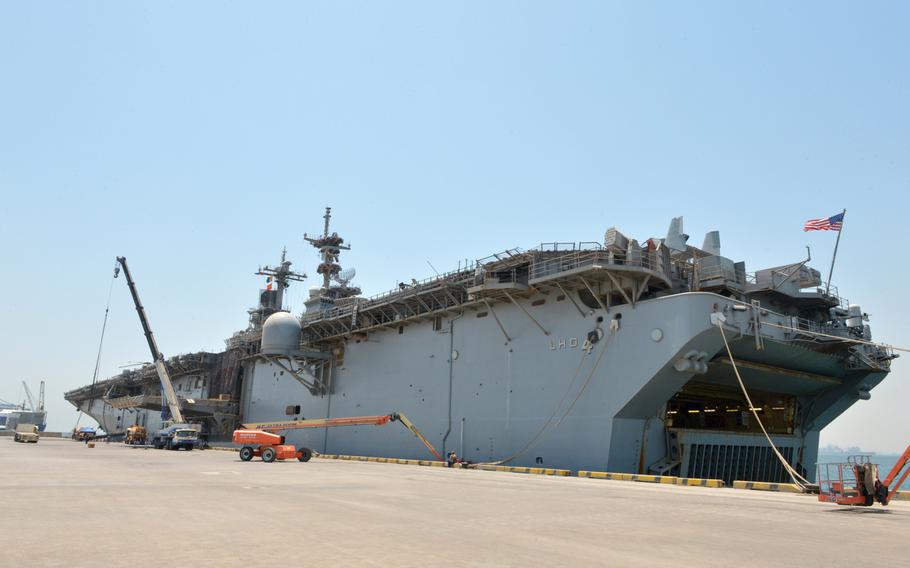
The amphibious assault ship USS Boxer is seen pierside at Bahrain's Khalifa bin Salman Port on Aug. 1, 2019. The Boxer pulled into Bahrain on July 25 for a scheduled weeklong port visit just days after making headlines for downing at least one drone during inbound transit through the Strait of Hormuz. (Joshua Karsten/Stars and Stripes)
MANAMA, Bahrain – The drone-downing USS Boxer is ready to counter “anything that’s thrown at us” by Iran should it encounter any new threats, the ship’s executive officer said prior to departing Bahrain on Friday following a scheduled weeklong port visit.
The San Diego-based amphibious assault ship pulled out of Bahrain’s Khalifa bin Salman port mid-morning on Friday with about 3,000 personnel embarked.
A day earlier, the ship was a hive of activity as sailors and Marines loaded stores, turned wrenches and painted the flight deck in preparation for getting back underway in the Persian Gulf.
Boxer made headlines last month when it downed at least one drone during its transit through the Strait of Hormuz.
President Donald Trump claimed the drone was Iranian and said it was destroyed after coming within about 1,000 yards of the vessel.
Tehran has disputed Washington’s account of the incident, insisting that all of its drones in the region landed back at their bases that day.
Boxer executive officer Capt. Dale Heinken told Stars and Stripes that interactions with Iran on the inbound transit through the Strait were “normal patterns of life.”
“We expected to see what we saw, and for the most part, it was exactly as we thought it would be,” Heinken said.
Heinken declined to talk about the downing of the drone on July 18, but said that his crew trains for contingencies when transiting close to Iranian shores.
As for the outbound transit, “I think we’re ready to counter anything that’s thrown at us,” Heinken said. “With that being said … I don’t expect anything out of the normal or any of the normal pattern of life that we’ve seen in the Arabian Gulf.”
Interactions with Iranian ships or aircraft in the Strait of Hormuz are considered routine, he said.
“We’d probably come out and want to see them as well if they were operating close to our homeland.”
The 96-mile-long Strait of Hormuz is bounded to the north by Iran and to the south by Oman and the United Arab Emirates. Around a fifth of the world’s oil last year passed through the strategic shipping route, which is only 21 miles wide at its narrowest point.
While Boxer operated in the Strait of Hormuz last month, the 11th Marine Expeditionary Unit aboard Boxer used an electronic jamming device as manned and unmanned Iranian aircraft swooped near the warship.
The Boxer downed one drone and engaged a second, Gen. Kenneth McKenzie, head of U.S. Central Command, told a CBS News reporter aboard the ship before pulling into Bahrain.
The two engagements happened about an hour apart, he said, but he was only confident that one of the drones was brought down.
Now a few weeks removed from the world spotlight, Boxer’s crew enjoyed some downtime in Bahrain after 42 days at sea. The ship departed Thailand in mid-June.
“Bahrain’s been fun,” said Petty Officer 2nd Class Jeremey Kowalski, one of five quartermasters on board. Kowalski said he spent most of his time at a quiet internet cafe so he could talk to friends and family back home.
Other crew members were seen at the base enlisted club and on “American alley,” a street just off base filled with restaurants.
The port visit also included training for the Marines and ship maintenance.
Boxer’s crew is divided almost equally between sailors and Marines. The Marines operate an Air Combat Element, or ACE, which consists of Harrier jets and Osprey tilt-rotor aircraft.
The ACE team is conducting sustainment training in Kuwait and will rejoin Boxer at a later date, 11th MEU spokesman Capt. Jim Stenger said.
The ship also carries Navy and Marine helicopter squadrons. Its interior is leveled to provide an upper and lower hangar bay, as well as a lower well deck capable of launching and recovering landing craft air cushion and amphibious assault vehicles.
Besides delivering Marines around the globe, the Boxer provides humanitarian assistance and takes part in disaster relief operations “that seem to be more frequent these days,” Heinken said.
Boxer and two support ships arrived in Middle East waters in June, as the U.S. stepped up the number of troops and equipment it has in the region in response to what Washington said were increased threats from Iran or its proxies.
“I’d say the primary reason” for Boxer’s mission in the region “is presence operations, but we also have that rapid response so if there’s a need to respond to a situation, we have that capability,” Heinken said.